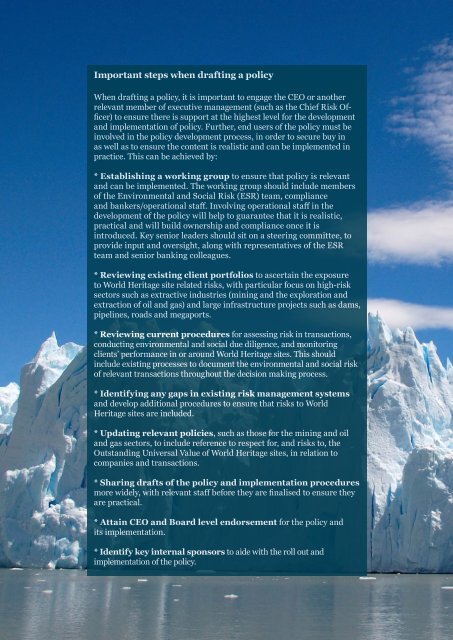Bios-Cons-Nat-Pro-155
You also want an ePaper? Increase the reach of your titles
YUMPU automatically turns print PDFs into web optimized ePapers that Google loves.
STRATEGIC REPORT<br />
19<br />
Important steps when drafting a policy<br />
When drafting a policy, it is important to engage the CEO or another<br />
relevant member of executive management (such as the Chief Risk Officer)<br />
to ensure there is support at the highest level for the development<br />
and implementation of policy. Further, end users of the policy must be<br />
involved in the policy development process, in order to secure buy in<br />
as well as to ensure the content is realistic and can be implemented in<br />
practice. This can be achieved by:<br />
Perito Moreno Glacier Los Glaciares<br />
<strong>Nat</strong>ional Park, Santa Cruz <strong>Pro</strong>vince,<br />
Patagonia, Argentina. UNESCO<br />
World Heritage Site<br />
© MICHEL GUNTHER / WWF<br />
* Establishing a working group to ensure that policy is relevant<br />
and can be implemented. The working group should include members<br />
of the Environmental and Social Risk (ESR) team, compliance<br />
and bankers/operational staff. Involving operational staff in the<br />
development of the policy will help to guarantee that it is realistic,<br />
practical and will build ownership and compliance once it is<br />
introduced. Key senior leaders should sit on a steering committee, to<br />
provide input and oversight, along with representatives of the ESR<br />
team and senior banking colleagues.<br />
* Reviewing existing client portfolios to ascertain the exposure<br />
to World Heritage site related risks, with particular focus on high-risk<br />
sectors such as extractive industries (mining and the exploration and<br />
extraction of oil and gas) and large infrastructure projects such as dams,<br />
pipelines, roads and megaports.<br />
* Reviewing current procedures for assessing risk in transactions,<br />
conducting environmental and social due diligence, and monitoring<br />
clients’ performance in or around World Heritage sites. This should<br />
include existing processes to document the environmental and social risk<br />
of relevant transactions throughout the decision making process.<br />
* Identifying any gaps in existing risk management systems<br />
and develop additional procedures to ensure that risks to World<br />
Heritage sites are included.<br />
* Updating relevant policies, such as those for the mining and oil<br />
and gas sectors, to include reference to respect for, and risks to, the<br />
Outstanding Universal Value of World Heritage sites, in relation to<br />
companies and transactions.<br />
* Sharing drafts of the policy and implementation procedures<br />
more widely, with relevant staff before they are finalised to ensure they<br />
are practical.<br />
* Attain CEO and Board level endorsement for the policy and<br />
its implementation.<br />
* Identify key internal sponsors to aide with the roll out and<br />
implementation of the policy.


